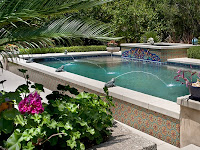Phosphates in Your Swimming Pool
Important: Algae must be treated before testing and lowering phosphates. Chlorine must be under 5ppm before testing phosphates.
Directions for the use of PHOSfree:
This product is designed for use in properly balanced pool water.
1. Clean or backwash filter.
2. Determine the appropriate dose. * See chart below.
3. Shake the bottle well before application. With the circulation pump running, add a dose to the skimmer.
4. filter for 48 hours continuously without backwashing or cleaning.
5. After 48 hours of filtering, clean/backwash filter. Retest phosphate levels, and if necessary, repeat steps 1-5.
Note: If DE filter pressure rises to 10psi above start-up pressure, turn the pump off for 1 minute and then turn it back on. If the pressure remains high,
backwash or rinse for 30 seconds.
Dosage Chart:
Dose per 10,000 gallons (38,000L)
Phosphate Level PHOSfree Dosage
300ppb or less 0.5L or 16oz
600ppb 1L or 32oz
900ppb 1.5L or 48oz
1200ppb 2L or 67.6oz
For DE & Cartridge Filters: Do not add 1.5L (48oz) simultaneously. If more than 1.5L (48oz) is needed to treat, be sure to clean or backwash
the filter between treatments.
Make sure you adjust the dosage based on your pool size. Adjust the dosage if you have a pool larger than the 10,000-gallon base chart, and change the dosage if your pool is less than 10,000 gallons.
Remember that phosphates are measured in ppb – parts per billion instead of the standard ppm – parts per million used in the industry. To give you an idea of how small a ppb is, imagine a roll of toilet paper stretched from New York across the Atlantic Ocean to London. One ppm would be one tiny sheet of the entire roll stretched across the ocean! So, a phosphate level of 100 ppb is extremely minuscule, but any amount of phosphates in the water is food for the algae. We are dealing with the microscopic world in your pool, and strangely, these very small amounts can destroy the pool's chlorine level and cause algae to bloom on the pool surface.
PoolRx is a Mineral Technology that does two straightforward things when used in your pool or spa: it eliminates all algae and allows you to use less chlorine during the pool season. Copper Sulphate, Pentahydrate, and silver (chelated) are active ingredients.
Chelated means that the PoolRx metals have been bonded to form two coordinated bonds similar to what Metal Sequestering Agents do. This means the metal ions will remain in the PoolRx unit, and no metal ions will be introduced into the pool or spa water. This prevents any metal staining on the pool surface.
Make sure you choose the correct size PoolRx+ unit to make the treatment effective. You can place it either in your skimmer or pump basket. When inserting the unit, run your pool for 3-4 hours. Then, run the standard cycle to get at least one complete water cycle from the pool, into the filter, and back into the pool again. The PoolRx+ unit should last 4-6 months.
PoolRx+ is also ideal for a saltwater pool. It will extend the life of your salt cell as you run the system at a lower output, while PoolRx+ is present in the pool, typically 50% less output. PoolRx+ minerals also include a de-scaler that will prevent scale from attaching to the salt cell, meaning less cell cleaning is needed. Also, since it generates less, the pH won't rise as high, requiring less acid added to the pool.
Using the PoolRX on your pool route will save you time and money. The manufacturer's claim of saving 20-30% on chemical costs is plausible, and once you try a PoolRx in one of your accounts, you will be amazed! With thousands of reviews online, this is an actual 5-star rated product.
PoolRx+ is a Mineral Technology that does two straightforward things when used in your pool or spa: it eliminates all algae and allows you to use less chlorine during the pool season. The active ingredients are Copper Sulphate, Pentahydrate, silver, & Zinc (chelated).
Video Outline:
Phosphates are an emerging problem in the industry
Orthophosphate into the water system to prevent pipes from rusting
That goes into your pool when you refill it
If your pool looks like this, you have phosphates in the water
Phosphates also enter the water through various consumer products
Also carried into the pool by wind
If you have algae in your pool, you have phosphates in the water
Test your pool phosphate level with a photometer or phosphate test strips
Phosphates are measured in PPB
Any phosphate level will lead to algae growth if left untreated
Phosphates are one food source for algae
300 BBP or more should be treated
Phosphate removers remove this food source for algae
High levels require commercial strength products like Orenda PR-10,000
Phopfree is an excellent option –
After you remove the phosphates, use a maintenance dose of Phospfree or a blended formula.
Perfect Weekly or Phosefree and Pool Perfect
PoolRx is also a great way to prevent algae in a pool with high phosphates
It is an algaecide that eliminates algae no matter the phosphate levels
If you want an algae-free pool all Summer long, it's important to check off phosphates and treat the pool immediately.
Visit my Website: http://www.swimmingpoollearning.com/

Comments
Post a Comment